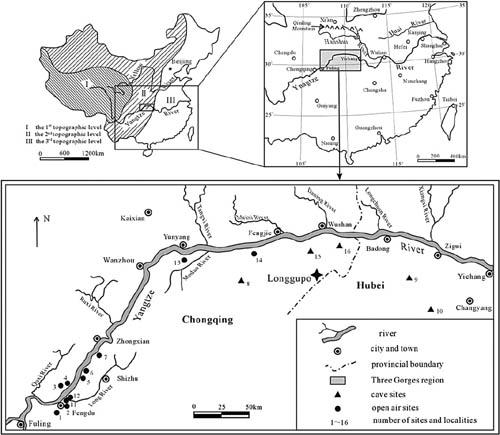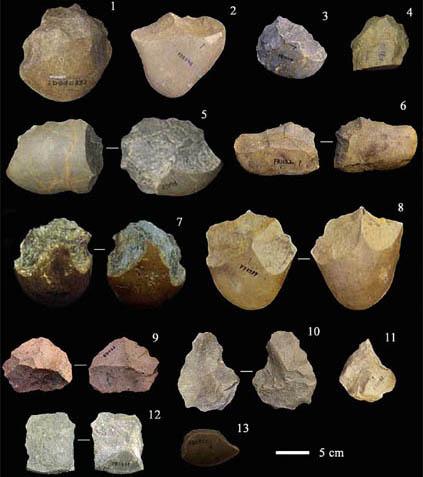Hominins already inhabited the Three Gorges region of South China in Pleistocene
Institute of Vertebrate Paleontology and Paleoanthropology
Source - http://phys.org/news/2012-12-hominins-inhabited-gorges-region-south.html

Fig.1 Geographic location of major paleoanthropological and Paleolithic sites in the Three Gorges region. Credit: PEI Shuwen
Systematic archaeological survey and excavations in the Three Gorges region, South China over the past two decades has led to the discovery of a number of important hominin fossils and Paleolithic stone artifact assemblages. Dr. PEI Shuwen, Institute of Vertebrate Paleontology and Paleoanthropology (IVPP), Chinese Academy of Sciences, and his collaborators reviewed the results of recent paleoanthropological, particularly Paleolithic archaeological, research from this region, and concluded that Middle to Late Pleistocene hominins already Inhabited the Three Gorges Region of South China and the Paleolithic technology is essentially an Oldowan-like industry (i.e., Mode 1 core and flake technologies). This study was published online in the journal of Quaternary International (2012).
The Three Gorges region is located in the transitional zone between the upper and middle reaches of the Yangtze River (Changjiang River). Vertebrate paleontological studies indicate that the faunas from this region belong primarily to the Ailuropoda-Stegodon faunal complex, a group of taxa representative of a subtropical forest environment. Systematic field surveys identified sixteen Paleolithic sites in caves and along the fluvial terraces of the Yangtze River. Geomorphology, biostratigraphy, and geochronology studies indicate that these sites were formed during the Middle to Late Pleistocene.
Three Gorges lithics are dominated by Mode 1 core and flake technologies. Lithic raw material exploited in the cave and open-air sites were primarily locally available river cobbles. The stone artifacts are relatively large, with the length of most artifacts between 100 and 200 mm, followed by artifacts between 50 and 100 mm.

Fig.2 The cores and retouched pieces from the Three Gorges region. Credit: PEI Shuwen
All flaking is by hard hammer percussion without core preparation. Interestingly, some flakes display evidence that anvil flaking and throwing flaking techniques were also utilized. Core reduction was primarily by unifacial flaking. Unifacial flaking is also demonstrated very clearly from the cortex flakes and platforms. The flake types show that flaking occurred in the region and also demonstrate the first stages of core reduction as represented by low percentage of Types III and VI.
The stone artifact assemblages from the region include cores, whole flakes, flake fragments and chunks, with a low percentage of retouched pieces. Unifacial choppers are the predominant core categories compared to the bifacial choppers, with sporadic discoids, polyhedrons and bifaces. Major blanks for retouched pieces are dominated by flakes and flake fragments.
Retouched pieces appear to be retouched unifacially by direct hammer stone percussion on the dorsal surface of the blanks. It should be noted that there are two protobifaces recovered from Ranjialukou, which at least superficially resemble western Old World Mode 2 Acheulean bifaces that were produced on cobbles and large flakes. However, there has been some reluctance in classifying the Ranjialukou bifaces as typical Acheulean, because they lack the characteristic shape, symmetry and flaking that are hallmark features of the Acheulean biface.
"Overall, the Three Gorges region stone toolkits can be characterized by a general lack of standardization of shape and an absence of formal tool categories. The heavy reliance on locally available, generally poor quality raw materials appears to have influenced the composition and morphology of the stone toolkits in the region", said PEI Shuwen, first author of the study.
"This study indicates that there has been a long history of hominin occupation in the Three Gorges region, likely more or less continuous during the Middle to Late Pleistocene, and possibly as far back as the early Early Pleistocene if the recent findings from Longgupo are eventually accepted by the broader scientific community", said coauthor GAO Xing of the IVPP, "Archaic Homo sapiens and modern H. sapiens identified from some of the cave deposits are likely the hominins responsible for the production of the stone artifacts".